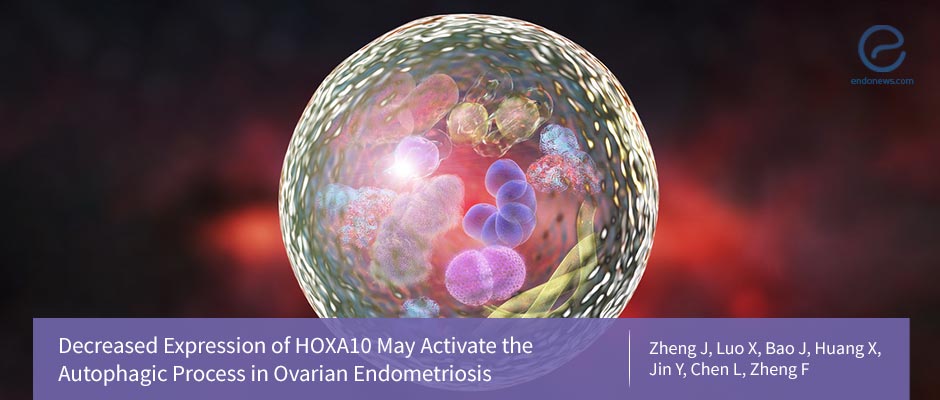HOXA10: A Culprit in Endometriosis Disease Progression
May 9, 2018
In order to activate autophagy, there needs to be a deficiency of HOXA10 in women suffering from endometriosis.
Key Points
Highlights:
- The researchers were testing the hypothesis "whether the Homeobox A10 (HOXA10) gene promote endometriosis by negatively regulating autophagy?"
- Also, the mechanism regulating autophagy in women with endometriosis was explored.
Importance:
- Research has yet to elucidate the mechanism that promotes endometriosis. Uncovering these mechanisms will lead to the development of effective targeted therapies.
What’s done here?
- Ovarian endometriotic tissues (OETs) and paired eutopic endometrial tissues (EETs) from 29 premenopausal women with endometriotic cysts with stage III or IV endometriosis were collected.
- Eutopic endometrial tissues (NETs) from 30 premenopausal women without endometriosis, who were undergoing laparoscopic myomectomy were also collected.
- All collected tissues were either used for RNA extraction to examine messenger RNA (mRNA) expression; western blotting used to quantify autophagic biomarkers (beclin-1 and LC3-II) and HOXA10 proteins expression or underwent Hematoxylin-Eosin staining to identify histological characteristics in the tissues of interest.
- Blood samples were used to determine serum cancer antigen 125 (CA125) concentrations.
- The data in this study was subject to statistical analysis.
Key results:
- Ovarian endometriomas had upregulated autophagic biomarker proteins and mRNAs and had decreased HOXA10 protein and mRNA.
- The eutopic endometrium of women with endometriosis was different from normal endometrium in terms of increased autophagy biomarkers protein levels.
- The researchers found a negative relationship between HOXA10 and autophagy.
- Women with endometriosis had a high Serum CA125, increasing with the stage of the disease; there was a positive link between serum CA125 and LC3-II protein levels, and LC3-II/LC3-I ratio.
- The researchers noted a negative relationship between the levels of serum CA125 and HOXA10 gene level.
- The overall conclusion reached is that a HOXA10 deficiency can lead to endometriosis.
- Further research needs to be conducted to establish the relationship between endometriosis, CA125, autophagy, and HOXA10.
Limitations of the study:
- The authors cite the stage of the menstrual cycle in which the samples are collected as one of the limitations of the study. Most samples were collected in the late proliferative phase and early secretory phase. This means that the authors were not able to determine trends in HOXA10 and autophagy-related proteins that synced with the menstrual cycle.
- Another limitation that was noted by the authors is the fact that histologic ectopic endometrial structure is different in different types of endometriosis. So, the ovarian lesions collected over the course of this study could have different ratios of endometriotic cell types.
Lay Summary
Zheng et al., a group of authors from the Aerospace Center Hospital in Bejing and from the First Affiliated Hospital of Wenzhou Medical University in Wenzhou, recently published a paper in Reproductive Sciences entitled “Decreased Expression of HOXA10 May Activate the Autophagic Process in Ovarian Endometriosis.” The authors wanted to see if the Homeobox A10 (HOXA10) gene plays a role in endometriosis disease progression by negatively regulating autophagy. In the same vein, the authors wanted to elucidate the exact mechanism regulating autophagy in women suffering from endometriosis.
The study was comprised of 29 premenopausal women with ovarian endometriotic cysts who were in the process of undergoing laparoscopic ovarian endometriosis cystectomy and hysteroscopy; ovarian endometriotic tissues (OETs) and paired eutopic endometrial tissues (EETs) were collected. As a control group, normal eutopic endometrial tissues (NETs) were collected from 30 premenopausal women who underwent a similar operation for uterine leiomyomas. All tissues were separated and subject to analysis.
Tissues were used for RNA extraction, to examine the messenger RNA (mRNA) expression levels, western blotting to quantify the autophagic biomarkers (beclin-1 and LC3-II) and HOXA10 proteins expression; or underwent hematoxylin-eosin staining to see histological characteristics of the tissues of interest. Blood samples were collected to analyze serum cancer antigen 125 (CA125) concentrations.
The researchers found that the ovarian endometriomas had upregulated autophagic biomarker proteins and mRNAs as well as decreased HOXA10 protein and mRNA. The one notable difference between the normal endometrium and the eutopic endometrium from women with endometriosis is that the eutopic endometrium has increased autophagic biomarkers protein expression levels. There was a negative correlation between HOXA10 and autophagy as well as the same relationship between serum CA125 level and HOXA10 gene level. They also noted a positive correlation between serum CA125 and LC3-II protein levels and/or LC3-II/LC3-I ratio. Overall, women with endometriosis had a high level of serum CA125 and this increased with the stage of endometriosis.
The researchers concluded that a HOXA10 deficiency can lead to autophagy in women with endometriosis. However, further research needs to be conducted to elucidate a relationship between endometriosis, CA125, autophagy, and HOXA10.
Research Source: https://www.ncbi.nlm.nih.gov/pubmed/29658437
HOXA10 autophagy gene ovarian endometriotic tissues eutopic endometrial tissues Quantitative real-time polymerase chain reaction mRNA western blot serum CA125 hematoxylin-eosin staining immunoassays

